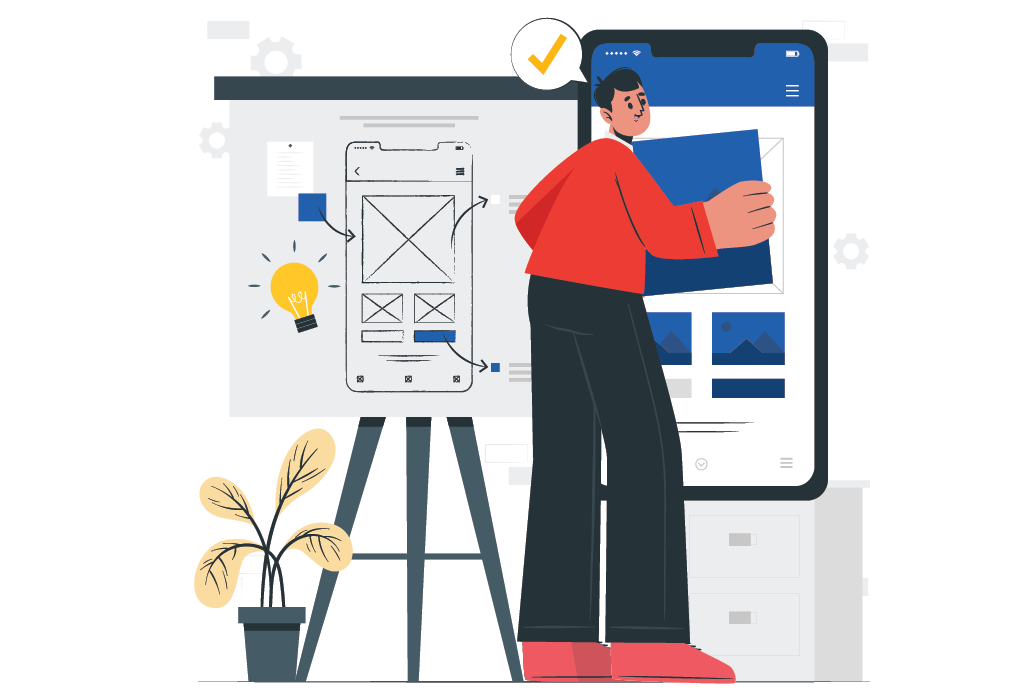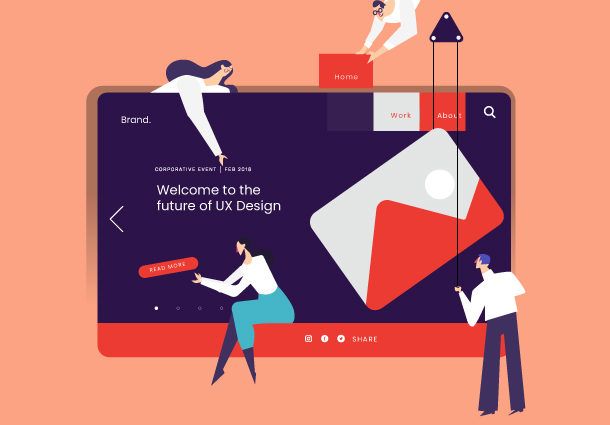The Human Touch in Enterprise Efficiency: The Role of UX Design
The pursuit of operational excellence is an ongoing endeavor in the quick-paced and dynamic environment of modern company. Businesses are increasingly looking to User Experience (UX) Design as a possible ally as they battle constantly changing obstacles. Although UX design is frequently connected to developing appealing and user-friendly user interfaces for products and applications, its potential goes well beyond aesthetics. This is where the idea of “Streamlining Operations Through Enterprise UX Design” comes into play, a progressive strategy that has gained traction in recent years. Understanding the complex workflows, procedures, and interactions that take place within an organization and using design principles to enhance and optimize these elements are at the heart of enterprise user experience design.  It’s a comprehensive strategy that aims to empower staff, simplify processes, and ultimately increase productivity. In essence, the goal is to create a work environment where technology promotes productivity rather than acting as a barrier to it.
It’s a comprehensive strategy that aims to empower staff, simplify processes, and ultimately increase productivity. In essence, the goal is to create a work environment where technology promotes productivity rather than acting as a barrier to it.
Beyond aesthetic improvements, enterprise UX design looks deeply into the nuances of how employees engage with systems, software, and one another. It pinpoints trouble spots, stumbling blocks, and locations where automation and user-centered solutions can fundamentally alter how work is carried out. Employee engagement, contentment, and overall performance can all significantly improve as a result of this strategy. In the context of “Streamlining Operations Through Enterprise UX Design,” we’ll take a journey through the ideas, approaches, and case studies that show how enterprise ux can revolutionize businesses. The possible applications are numerous and extensive, ranging from redesigning intricate data input procedures to creating user-friendly dashboards for data-driven decision-making.
Beyond Aesthetics: The Substantial ROI of Enterprise UX Design
User Experience (UX) Design has become a strategic necessity in the dynamic business world where effectiveness, productivity, and user pleasure are crucial. UX design no longer just pertains to consumer-facing goods; it now plays a critical role in the success of organizations of all sizes. Why do businesses need UX design?
First and foremost, improving staff productivity may be sparked by UX design. Businesses are intricate ecologies with many tools, databases, and software programs that people use on a regular basis. A well-designed enterprise user experience can shorten the time and effort needed to complete tasks by streamlining workflows, making jobs simpler, and providing intuitive interfaces. Additionally, UX design promotes a user-centric culture within a business. Businesses may create a more engaging and satisfying work environment by putting their employees’ needs and preferences first.  Employees are more likely to be motivated, productive, and devoted to the company when they believe that the tools and processes they use are made with their best interests in mind.
Employees are more likely to be motivated, productive, and devoted to the company when they believe that the tools and processes they use are made with their best interests in mind.
A significant factor in efficient data consumption is UX design. The ability to access, evaluate, and act on data is crucial in today’s data-driven organizations. Organizations may become more agile and responsive by enabling employees to make quick, informed decisions using well-designed dashboards and data visualization tools. The significance of UX design is also highlighted by the rise in mobile and remote working practices among enterprises. UX designers are excellent at conquering the issue of designing for many devices and platforms while maintaining a consistent and user-friendly experience.
For businesses, UX design is a strategic necessity, not just a nice to have. It increases output, promotes a user-centric culture, maximizes data use, and adjusts to the changing nature of the workplace. Businesses that invest in UX design get a competitive edge and a more adaptable, effective, and engaged staff in a world where operational excellence and employee satisfaction are crucial.
AR, VR, and Beyond: A Visionary Voyage in UX
The field of user experience (UX) design is dynamic and constantly changing as a result of how people’ requirements and tastes have changed in the digital era. A number of significant UX design trends have surfaced, influencing the production and consumption of digital experiences. With clear and uncluttered interfaces that put user focus and usability first, minimalism and simplicity are at the forefront. Dark mode has grown in popularity because it provides slick and aesthetically pleasing designs while minimizing eye strain and conserving battery life.  The adoption of voice user interfaces (VUIs), which allow users to communicate with devices and apps using natural language, is on the rise. Virtual reality (VR) and augmented reality (AR) technologies are pushing the envelope and producing engaging experiences. Users are more engaged when there are micro-interactions, such as brief animations or feedback on their actions. In order to ensure that people with disabilities can use digital experiences, accessibility and inclusion are now essential.
The adoption of voice user interfaces (VUIs), which allow users to communicate with devices and apps using natural language, is on the rise. Virtual reality (VR) and augmented reality (AR) technologies are pushing the envelope and producing engaging experiences. Users are more engaged when there are micro-interactions, such as brief animations or feedback on their actions. In order to ensure that people with disabilities can use digital experiences, accessibility and inclusion are now essential.
By customizing information and recommendations for each user, personalization, powered by AI and machine learning, boosts engagement. An increasing concern is sustainability, and UX designers are working to lessen the environmental impact of digital products. Gesture-based navigation has become more popular, particularly with the rise in popularity of touch-screen gadgets. Deeper relationships between users and digital products or services are fostered by emotional design, which strives to produce emotionally resonant experiences. For designers and organizations looking to offer excellent user experiences and stay competitive in a constantly changing digital market, staying up to date on best enterprise UX design trends is crucial.
Building Trust Through Transparency and Communication: Meeting End-User Expectations
Enterprises must modify their investment strategies to fit the changing user-centricity landscape in a time when end users have major influence over decision-making procedures. In the past, businesses mainly concentrated on internal operations and product development, with little direct contact with end users. However, the digital era has brought about a paradigm change in which end users, equipped with social media and quick feedback channels, may significantly affect the success and reputation of an organization.
Customer experience (CX) is one essential area in which businesses should focus. Understanding end users’ wants, preferences, and pain points when they interact with the company’s goods or services is necessary for prioritizing CX. Customized experiences that appeal with customers, encourage loyalty, and promote brand support can be created by investing in user research, user testing, and iterative design processes. The whole customer experience can be improved by investing in CRM (Customer Relationship Management) systems and AI-driven personalization technologies, which can enable businesses to deliver more individualized and responsive interactions.
Investments in data analytics and AI-driven insights are another crucial area.  Enterprises may better understand end-user behavior, preferences, and trends by utilizing data analytics. Organizations can optimize product offerings, make educated decisions, and successfully target specific user segments with marketing campaigns by using this data-driven strategy. Furthermore, AI-driven insights may automatically analyze huge datasets, revealing important patterns and trends that could otherwise go overlooked.
Enterprises may better understand end-user behavior, preferences, and trends by utilizing data analytics. Organizations can optimize product offerings, make educated decisions, and successfully target specific user segments with marketing campaigns by using this data-driven strategy. Furthermore, AI-driven insights may automatically analyze huge datasets, revealing important patterns and trends that could otherwise go overlooked.
Investments in staff engagement and training are also essential. Employees on the front lines who deal with end customers on a daily basis need to be knowledgeable and skilled in order to provide outstanding service and support. The capacity of an organization to meet the changing expectations of end users can be improved by investing in continual training and offering chances for employee feedback. Focusing investments on customer experience, data analytics, AI-driven insights, and staff training may allow enterprises to succeed in this user-centric environment as end users continue to have a say in enterprise choices. Businesses that put a high priority on these areas will be better able to maintain relationships with customers, adjust to shifting market conditions, and promote sustainable growth in the current digital era.
Building Stronger Connections: The Future of Enterprise Success
Enterprises must change their investment strategies to prioritize user-centricity in a world where end users have an unprecedented amount of power. Customer experience (CX) and data-driven insights are becoming a strategic necessity rather than just a trend. Organizations may ensure their relevance and longevity in a market environment that is always changing by investing in knowing and gratifying end customers.
Companies should engage in staff training to guarantee front-line personnel can meet changing consumer expectations, commit resources to improving CX through customized experiences, and use data analytics and AI-driven insights for informed decision-making. In the era of digital influence, such investments enable firms to create solid, long-lasting connections with end users, inspire trust, and promote sustainable growth.
Pattem Digital stands out as a reliable option when looking for partners to carry out these strategies as the best UX design agency. We are set to lead businesses on their journey to align with the shifting end-user influence because of its track record of delivering user-centric solutions and dedication to innovation. Enterprises that choose Pattem Digital have access to a team of specialists who are committed to comprehending customer needs, utilizing data insights, and providing customized experiences that guarantee long-term success in the user-driven digital era.


